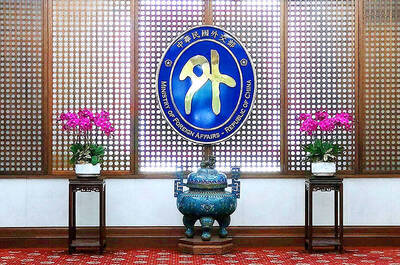A roadside detection system to help protect endangered leopard cats from being hit by passing vehicles was unveiled on Friday in northern Taiwan.
The system, the first of its kind, was developed by the Endemic Species Research Institute and National Chung Hsing University in a project initiated by the Directorate-General of Highways.
It uses thermal imaging cameras and artificial intelligence-powered recognition software to identify leopard cats and display a warning message on a traffic sign 1km ahead of where the animal is detected.

Photo: CNA
The system warns drivers and gives them time to take precautions, said Chiang Ya-yu (蔣雅郁), an assistant professor at the university’s Department of Mechanical Engineering.
It emits pulsing lights and sound to discourage the animal from crossing the road, Chiang said.
The system, installed on the Jhuolan section of Provincial Highway No. 3, can also detect Chinese ferret-badgers and Formosan gem-faced civets, Chiang added.
Sixteen cameras have been set up along the stretch of road to collect data, the highway authority said, adding that depending on the results, it might expand the system to other places.
There are less than 500 leopard cats in the wild nationwide, and most can be found in Taichung, and Miaoli and Nantou counties, the Leopard Cat Association of Taiwan said.
Four leopard cats have been reported killed by traffic so far this year.

The Ministry of Foreign Affairs (MOFA) yesterday voiced dissatisfaction with the Comprehensive and Progressive Agreement for Trans- Pacific Partnership (CPTPP), whose latest meeting, concluded earlier the same day, appeared not to address the country’s application. In a statement, MOFA said the CPTPP commission had "once again failed to fairly process Taiwan’s application," attributing the inaction to the bloc’s "succumbing to political pressure," without elaborating. Taiwan submitted its CPTPP application under the name "Separate Customs Territory of Taiwan, Penghu, Kinmen and Matsu" on Sept. 22, 2021 -- less than a week after China

THE GOOD WORD: More than 100 colleges on both sides of the Pacific will work together to bring students to Taiwan so they can learn Mandarin where it is spoken A total of 102 universities from Taiwan and the US are collaborating in a push to promote Taiwan as the first-choice place to learn Mandarin, with seven Mandarin learning centers stood up in the US to train and support teachers, the Foundation for International Cooperation in Higher Education of Taiwan (FICHET) said. At the annual convention of the American Council on the Teaching of Foreign Languages held over the weekend in New Orleans, Louisiana, a Taiwan Pavilion was jointly run by 17 representative teams from the FICHET, the Overseas Community Affairs Council, the Steering Committee for the Test of Proficiency-Huayu, the

A home-style restaurant opened by a Taiwanese woman in Quezon City in Metro Manila has been featured in the first-ever Michelin Guide honoring exceptional restaurants in the Philippines. The restaurant, Fong Wei Wu (豐味屋), was one of 74 eateries to receive a “Michelin Selected” honor in the guide, while one restaurant received two Michelin stars, eight received one star and 25 were awarded a “Bib Gourmand.” The guide, which was limited to restaurants in Metro Manila and Cebu, was published on Oct. 30. In an interview, Feng Wei Wu’s owner and chef, Linda, said that as a restaurateur in her 60s, receiving an

MORE RETALIATION: China would adopt a long-term pressure strategy to prevent other countries or future prime ministers following in Sanae Takaichi’s steps, an academic said Taiwan should maintain communications with Japan, as Japanese Prime Minister Sanae Takaichi is to lead a revision of security documents, Taiwanese academics said yesterday. Tensions have risen between Japan and China over remarks by Takaichi earlier this month that the use of force against Taiwan would constitute a “survival-threatening situation” for Japan. Prospect Foundation president Lai I-chung (賴怡忠) yesterday said Takaichi’s stance regarding Taiwan is the same as past Japanese prime ministers, but her position is clearer than that of her predecessors Fumio Kishida and Shigeru Ishiba. Although Japan views a “Taiwan contingency” as a “survival-threatening situation,” which would allow its military to